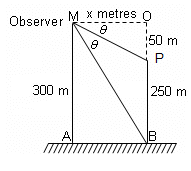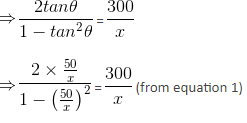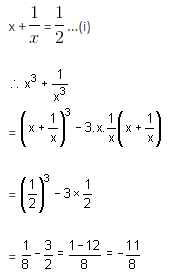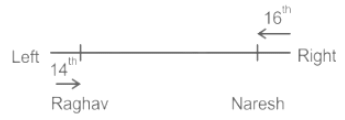SSC CGL (Tier II) Practice Test - 2 - SSC CGL MCQ
30 Questions MCQ Test SSC CGL Tier II Mock Test Series 2025 - SSC CGL (Tier II) Practice Test - 2
In the given figure, PQ is the diameter of a circle with radius 5 cm. If the length of RS is 6 cm, then what is the area of the trapezium PQRS?


If xy = 11 and x – y = 5, then x3y2 – x2y3 equals
Aman and Farhan can complete a work in 30 days. Aman works for 16 days and Farhan finishes remaining work in 44 days. In how many days will Farhan complete the work alone?
Four strips of paneling, each 40 cm long and 4 cm wide, are arranged to form a square as shown below. What is the area of the inner square (in cm2)?

When 80% of a number is added to 80, the total is the same number again. Which of the following is that number?
A 50 m high pole stands on a 250 m high building. To an observer at a height of 300 m, the building and the pole subtend equal angles. The distance of the observer from the top of the pole is
If an amount of $665 is distributed among A, B and C in the ratio (2/3) : (3/4) : (4/5), how much would be the share of A?
Three angles of a quadrilateral are in the ratio 10 : 8 : 7, and the fourth angle measures 60°. What is the difference between the largest and the smallest angles?
In a cricket match, Rahul and Sachin respectively scored 1/9th and 2/11th parts of the total runs. What part of the total runs did they collectively score?
A number, when divided successively by 4, 5 and 6, leaves remainders 2, 3 and 4, respectively. The least such number is
Two trains, 100 m and 120 m long, travelling in opposite directions cross each other in 4 seconds. If the speed of one of the trains 90 km/hr, what is the speed of the other?
If P = 229 × 321 × 58, Q = 227 × 321 × 58, R = 226 × 322 × 58 and S = 225 × 322 × 59, then which of the following is TRUE?
Direction: Read the given statements and conclusions carefully. Assuming that the information given in the statements is true, even if it appears to be at variance with commonly known facts, decide which of the given conclusions logically follow(s) from the statements.
Statements:
1) All cars are equipment.
2) Some bikes are cars.
3) Some cars are begs.
4) All begs are books.
Conclusions:
1) Some bikes are begs.
2) Some books are bikes.
3) All begs are equipment.
4) Some books are equipment.
How many four letter meaningful words can be made from the 3rd, 5th, 6th and the last letter of the word EVENTFUL?
Select the number from among the given options that can replace the question mark (?) in the following matrix.

A clock is set right at 5 am. The clock loses 16 minutes in 24 hours. What will be the true time when clock indicates 10 pm on 4th day?
In a row of people, Raghav is standing at the 14th position from the extreme left end and Naresh is at the 16th position from the extreme right end. If they interchange their respective positions, Raghav now becomes 23rd from the extreme left end.
Q. What is the position of Naresh from the extreme right end after the interchange?
In the following question, select the odd number pair from the given alternatives.
How many triangles are present in the picture below?

If in a certain code language, SCIENCE is coded as GFRVMFU, how PHYSICS written in that code language?
Select the correct combination of mathematical signs to replace the * signs and to balance the given equation.
25 * 7 * 56 * 8 * 88 * 14
In each of the given number-clusters, the number on the right side of '=' (the equal to sign) is calculated by performing certain mathematical operations on the three numbers on the left of '=' (the equal to sign). All three number-clusters follow the same pattern. Select the number from among the given options that can replace the question mark (?) in the third number-cluster.
4, 3, 2 = 21
5, 6, 3 = 52
5, 8, 4 = ?
Given below are two statements, one is labelled as Assertion (A) and the other is labelled as Reason (R)
Assertion (A): Selecting the right man for the right job at the right pay is the right approach.
Reason (R): A wrongly selected man is a liability.
In the above context, which one of the following is correct?
Seven people – G, H, J, K, L, M and N are sitting in the same row at an equal distance facing towards the south, but not necessarily in the same order. K is sitting fourth to the left of N. G is sitting immediate left of K. Two people are sitting between M and G. The number of people sitting between H and J is the same as the number of people sitting between J and L. H is not sitting at any of the extreme ends. Who among the following group of people is sitting to the right of M?
Direction: In following question two conclusions have been given followed by 4 sets of possible Statements. You have to take the given Conclusions to be true even if they seem to be at variance with the commonly known facts and then decide for the given Conclusions logically follows from the which of the given statements disregarding commonly known facts.
Conclusions:
I. No bag is book is a possibility.
II. Some book can never be copy.
III. All book can be pen.
Statements:
I. Only a few book are pen. Some bag are book. No pen is bag. Some pen is copy.
II. No bag are book. No pen is bag. Only pen is copy. Only a few book are pen.
III. Some bag are not book. No pen is bag. Only pen is copy. Some book are pen.
IV. Only a few book are pen. Some bag are book. No pen is bag. Only pen is copy
If “PURPLE” is coded as “517515” then how will “ORANGE” be coded as?
At a retail shop, coins worth ₹2,160 were collected in a day, including ₹1, 2, 5, and 10 coins. If the number of ₹2 coins was 10 more than the number of ₹10 coins, 20 more than the number of ₹5 coins, but 20 less than the number of ₹1 coins, then what was the number of ₹10 coins?
|
66 docs|139 tests
|




































